100% renewable grid: just how feasible is it?
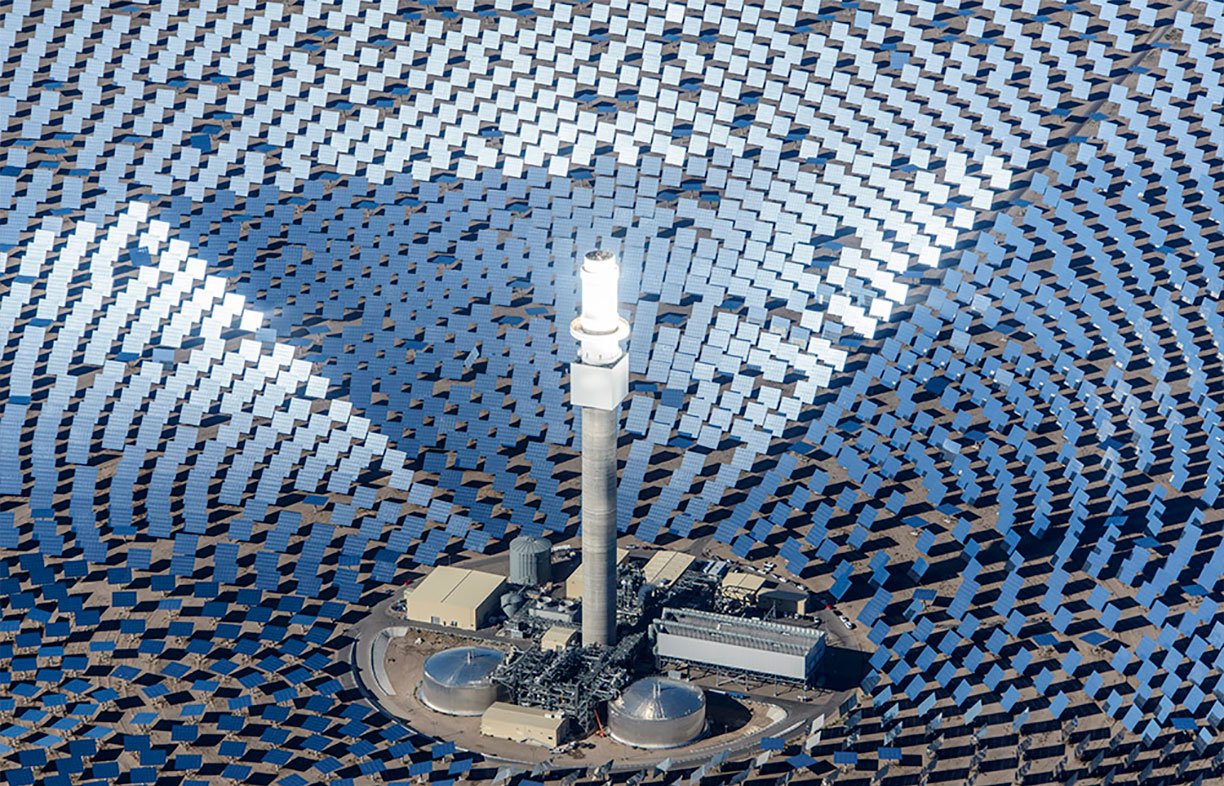
With ongoing discussion by government and media about the effect of renewables on the grid, Renew’s Andrew Reddaway and Damien Moyse consider the feasibility of 100% renewables for Australia.
This article was first published in Issue 138 (January-March 2017) of Renew magazine.
Renew (Renew magazine’s publisher) supports a transition from fossil fuels to renewable generation in Australia’s electricity grid. As well as being important to meet our international commitments to fight climate change, this brings other benefits such as improved local health outcomes, greater energy security and more jobs.
However, as this transition progresses we must ensure the grid remains reliable and avoid economic hardship. How can this be achieved as we approach 100% renewables? This article considers the challenges of relying on intermittent generation, ways to address those challenges and a plan for moving forward.
The challenge of intermittent generation
Our ageing coal-fired generators
The average age of a coal-fired power station in Australia is nearly 30 years, and some are operating beyond their design life. For example, Hazelwood started up in 1964. In the absence of renewables, substantial investment would be required to rebuild or renovate these old assets.
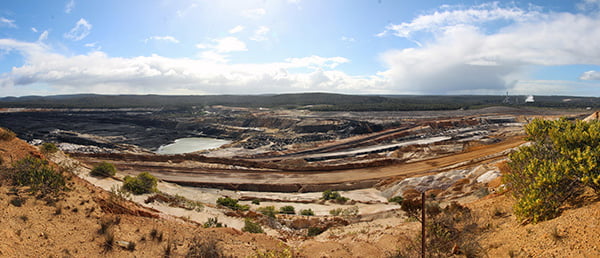
Coal electricity’s current low wholesale price (about 4 to 5 c/kWh) is possible because these power stations were paid off decades ago. Energy from a newly-built coal generator would cost more. The best estimates for future costs are in the Australian Power Generation Technology Report (www.bit.ly/2fPnLdt), which estimates that the average cost of electricity over a new coal plant’s lifespan (excluding decommissioning) is about 8 c/kWh. Allowing for profit margins, the price would be even higher. This report also found that new power stations fuelled by natural gas will have a similar cost, assuming they are of the most efficient type.
Wind and solar: the front-runners
Wind and solar farms are the cheapest renewable options, generating electricity at around 10 c/kWh and 14 c/kWh respectively, averaged over their lifespan. Those costs are for 2015, and they’re dropping fast, expected to reach around 7 c/kWh and 8 c/kWh respectively by 2030 (see Figure 1). Operating costs are very low (the fuel is free!), so the dominant factor is capital costs, calculated assuming an 8% cost of debt. Money can currently be borrowed more cheaply than this, assisting new renewable generators to commit to sell electricity below 8 c/kWh in Australia and below US 5 c/kWh overseas.
(With such prices for electricity generation, you may be wondering why you’re paying 25 to 35 c/kWh for electricity from the grid. The bulk of your bill pays for other factors such as poles and wires, retail billing costs, profit margins etc.)
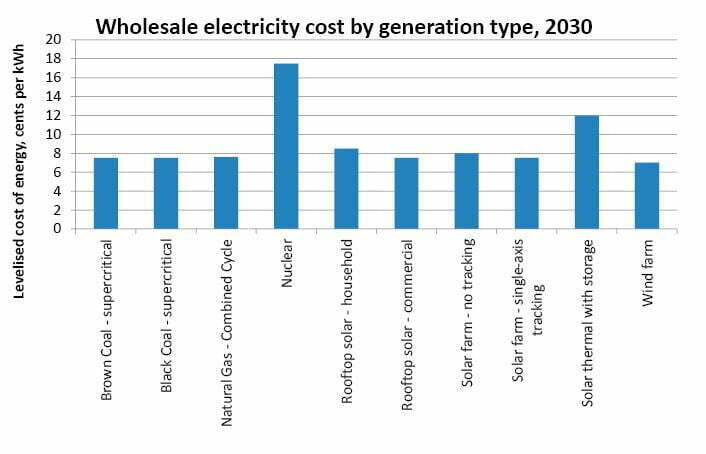
The main drawback of wind and solar is that they operate intermittently, depending on weather conditions. However, their generation is very predictable using short-term weather forecasting and cloud tracking techniques. Some people worry about the energy required in construction, but modern turbines and panels recoup this very rapidly. For more information, see ‘How green is my solar’ in ReNew 135.
Tidal and wave power are also intermittent renewable energy sources, but their development lags far behind wind and solar.
Base load vs peakers
Fossil fuel power stations are often called ‘base load’ generators, meaning that they are not intermittent and can be dispatched as required by the grid operator (‘dispatchable’). This is a very useful feature, as our current grid has almost no capacity to store electricity and must be balanced minute-by-minute. The term ‘base load’ originally referred to the grid’s minimum demand for electricity that was always present. Traditionally, coal-fired power stations preferred to never shut down, so electricity demand at quiet times was incentivised; for example household electric hot water tanks would switch on around 1 am. Relatively modern coal generators do have reasonable flexibility, such as Loy Yang A which can halve its output in less than an hour.
Natural gas is another fossil fuel that can be burnt to generate electricity. Some gas power stations are reasonably efficient and operate as ‘base load’ generators. Other types are different: cheap to build, but expensive to run because their efficiency is low so they require a lot of gas. These are referred to as ‘peakers’, because they can respond quickly to supply demand peaks when called upon by the grid operator. Although these power stations sit idle for most of the time they are still profitable, because they only operate when the wholesale electricity price is high. Hydroelectric generators are also commonly used as ‘peakers’.
A cloudy, calm week
The main challenge for renewables is to supply an extended period when wind and sunlight are scarce. In response, plans for 100% renewables tend to employ a mix of solutions. A partial answer is to simply build extra solar panels and wind turbines to maximise generation when the resource is weak. However, dispatchable forms of renewable energy are available.
Hydroelectric generation from large dams is a big, existing, dispatchable renewable electricity source but has little expansion potential as few suitable sites exist in Australia.
A useful dispatchable generation option is biomass, using plant material such as crop stubble, sawdust and woody waste. For example, sugar processing plants have generated electricity for over 100 years by burning sugar cane residues (bagasse) left over after sugar extraction. To mitigate transport costs, biomass can be made into pellets. This fuel can be sustainable as long as the plant material is regrown thoughtfully. Alternative uses for biomass must be considered: if this organic material is normally returned to the soil, taking it for energy instead could eventually degrade the land. Farmland can be used to create renewable liquid fuels, for example ethanol from sugar or wheat, and biodiesel from oil crops. However, heavy use of such biofuel is problematic as it competes with food production.
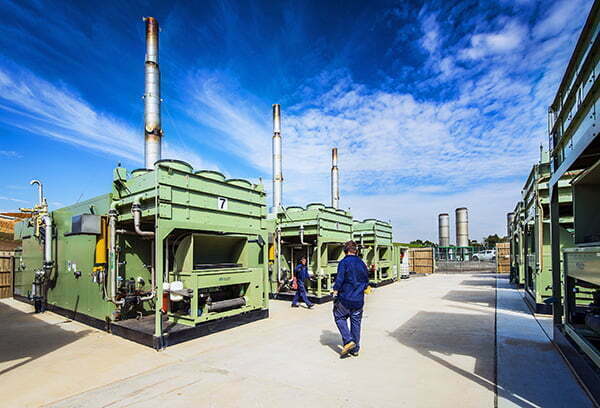
It’s already common for landfill sites to collect methane gas (known as biogas) that leaks from the site and burn it to generate electricity. This gas could be captured from many more sources, such as sewage treatment plants and farms. Burning this methane has an additional environmental benefit because if it’s allowed to escape unburnt to the upper atmosphere its greenhouse effect is much more potent than carbon dioxide. Biogas can also be created from biomass.
Geothermal power plants draw energy from underground heat sources; Birdsville’s electricity is partially supplied this way. Massive resources of deep ‘hot rocks’ exist in central Australia and Victoria, but the pilot projects run over the past few years to harness this power have not been successful.
Ways to cope with intermittent generation
Connecting the states
Australia is well endowed with wind and sunshine—the entire continent is never cloudy and still simultaneously. The intermittency problem can be mitigated by dispersing wind and solar farms around the country and sharing their generation. Originally each state’s electricity grid was separate, but in recent decades they have all been interconnected to the National Electricity Market (NEM) except for WA and the NT. Presently the interconnecting cables are few and their capacity is small, so each state can only export a fraction of its generation at any time.
Tasmania is a good example. It has huge generation potential from the ‘roaring forties’ winds that blow over its land mass and smaller islands. But it’s connected to Victoria by just a single cable that failed in 2016 (taking six months to repair) and also failed during a 35 degree heatwave in 2009.
South Australia’s grid has only two connections, both with Victoria. To share renewable generation more widely, new inter-connectors have been proposed to NSW and QLD. Some plans include connecting WA to SA.
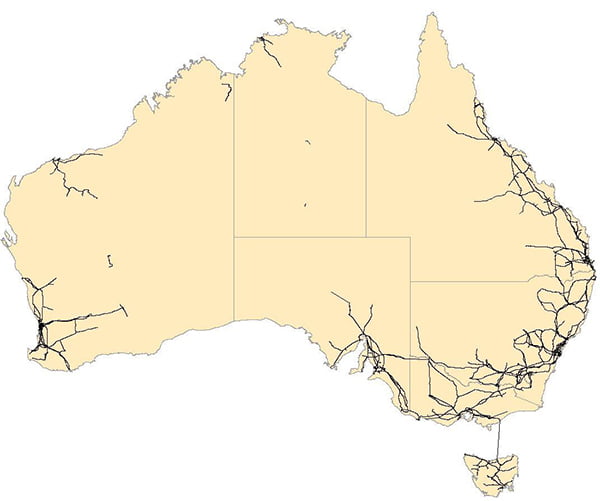
Energy storage
It is possible to store energy and then use it to generate electricity during a cloudy, calm period. The biggest existing store of renewable energy is rainwater held in large hydroelectric dams. Few of these can recycle their water; after flowing through and turning the generator it heads away downriver. Ideally this water would be captured in a lower dam and then pumped back to the upper level at windy or sunny times.
You don’t have to dam a river to store energy using pumped hydro. According to the Melbourne Energy Institute, the best option is to build a dam on a tall hill or cliff. This height creates strong water pressure, enabling significant energy to be stored with a relatively small dam. Suitable sites are plentiful, and the theoretical cost is $200 per kWh of usable storage capacity. When added to a solar farm, a dam to store five hours of generation would increase the system cost by about 25%.
Concentrated solar thermal (CST) plants collect and store energy like an enormous solar hot water system. Mirrors reflect and concentrate sunlight, heating a fluid such as molten salt up to 300 to 1000 degrees Celsius. The fluid is stored in an insulated tank; when required, the heat boils water into steam to spin an electric generator. This technology has been proven, notably in the USA and Spain, and at Liddell in NSW. Electricity from a plant built in 2015 with six hours of storage is estimated to cost about 24c/kWh averaged over its lifespan. This is projected to halve to 12c/kWh by 2030.
Batteries can be used to store energy either in central locations or distributed close to the point of electricity consumption. Household batteries for solar systems currently cost around $1200 per kWh of storage capacity, which is expected to drop to around $700 by 2030. Larger batteries for industrial and commercial use are cheaper.
Biomass pellets and biogas can also be stored for later electricity generation. In a 100% renewable scenario, biogas could be stored and distributed in the pipeline infrastructure currently used for fossil gas. Renewable electricity can also be used to produce hydrogen gas from water, to be used in vehicle engines, for heating buildings or used for electricity generation later on.
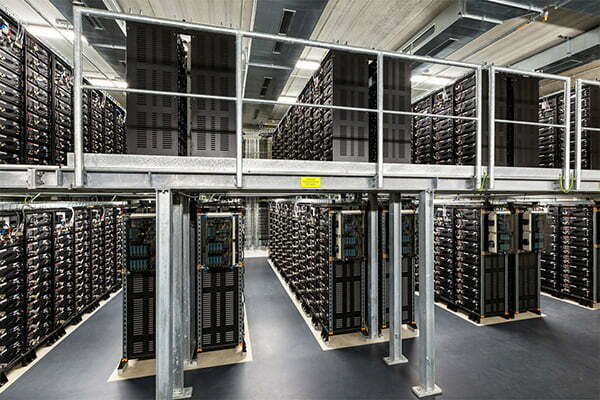
Energy efficiency
Australia has an opportunity for huge bill savings from reduced energy consumption, and this becomes imperative in a 100% renewable world. Heating buildings in southern states is especially important, as this consumes large amounts of energy at times when sunshine is scarce. Retrofits such as draft sealing and insulation pay for themselves very quickly, and are one reason why an average German household consumes only about half as much electricity as an Australian one. Efficiency keeps German residential electricity bills small, even though their tariffs are relatively high. Modern reverse-cycle air conditioners are now the most efficient and cheapest way to heat buildings, fitting in well with renewable electricity generation.
Commerce and industry make up about 70% of Australia’s electricity consumption and measures have already been identified for substantial reductions in this sector’s energy use.
Flexible demand
We expect an instant response when we switch on most appliances, but some electricity consumption can be postponed or brought forward to suit available generation. Timers on electric hot water tanks can be changed from night-time to daytime, as is already happening in Queensland. Swimming pool water must be filtered, but this can be done at any time of the day.
Electric vehicle (EV) charging is also a good opportunity, as most people only use a fraction of their car’s battery capacity each day. Cars can be plugged in to chargers while parked in home garages or car parks. Drivers could nominate their preferences, perhaps paying less if they allow more flexibility in charging time. If EV chargers can avoid peak times for demand on the grid, their additional electricity consumption will help smooth out peaks and troughs in grid demand. This might even the reduce the tariff you pay for each kilowatt-hour due to economies of scale from higher consumption.
Large opportunities for demand response exist in industrial processes.
What about grid stability?
Even when generation is plentiful, an electricity grid can be blacked out by a brief disruption. The grid operates like a team of people pedalling stationary bicycles to power a building. If some bikes suddenly disconnect (e.g. if their electricity connection is severed), the remaining generators will immediately feel extra resistance and their cadence will slow.
If you look at the label on a household appliance, you’ll probably see the term AC for alternating current. This means that electricity is alternately pushed from the grid into your house, then sucked back again in the reverse direction. The frequency of this direction change is 50 cycles per second, or 50 Hertz (Hz), which is the heartbeat of the grid. From Cairns to Melbourne to Adelaide, electric generators and motors spin precisely synchronised to this pulse.
Generators can be damaged if the grid frequency slows below 48 or 49 Hertz, so if this occurs they may switch off to protect themselves. These shutdowns (or ‘trips’) place extra resistance on the remaining generators, causing further disconnections and a blackout. To keep grid frequency stable, some generators run their turbines below full power, reserving generation capacity to jump in and inject extra electricity as soon as a drop in grid frequency is detected. Part of our electricity bills pays for this service to keep the grid stable, sometimes referred to as ‘frequency control ancillary services’ (FCAS) or ‘spinning reserve’—payments amount to about 1% of the wholesale trade in electricity.
A coal-fired power station that shuts down unexpectedly can create a large disruption to the grid. In recent years coal generators have been closed by bushfires, flooding and coal quality issues. If the grid were instead served by a larger number of smaller, widely-spaced generators, the potential shock would be reduced.
Grid stability is assisted by generators that have heavy spinning parts synchronised to the grid frequency, such as fossil fuel and hydroelectric turbines. Due to their inertia it takes significant energy to start such turbines rotating, but once up to speed they similarly resist slowing down. Thanks to inertia, frequency slowdowns due to grid disruptions occur more gradually. In an emergency the frequency might take 0.5 seconds to drop from 50 to 49 Hertz, rather than 0.2 seconds if the grid had less inertia. This provides sufficient time for protective mechanisms such as FCAS to kick in.
Are wind and solar reducing grid stability?
The blades of modern wind turbines are not synchronised with the grid’s frequency. Instead, rotation speed is constantly adjusted to harvest maximum energy from prevailing wind conditions. And solar panels have no rotating components at all. So how can wind turbines and solar panels generate electricity compatible with the grid, pulsing at exactly the right frequency? They use clever electrical components to convert their “asynchronous” generation into electricity with a suitable alternating current. A modern wind generator’s electrical output is decoupled from its mechanical input. The blades and hub may weigh over 20 tonnes and rotate 20 times per minute, but this mechanical inertia is not readily available as electrical inertia.
As wind turbines and solar panels replace fossil-fuel generators, overall levels of inertia in the grid are falling. If not managed, this trend could reduce grid stability and make blackouts more likely in the future. Industry is well-aware of this issue, as described in AEMO’s ‘Wind Integration Studies’ in 2011—2013.
Generators are not required to have inertia, but they must be able to tolerate grid faults that arise. For example, if the grid voltage drops to zero for a fraction of a second, standards require a generator to have resilience to ‘ride-through’ the fault and keep operating, assisting the grid to recover. Similarly, if the grid frequency dips temporarily, the generator must continue operating. Wind and solar farms are installed with smart electrical components to comply with these requirements. The South Australian blackout in October 2016 showed that existing wind farms can successfully ride-through even very severe grid faults, as long as they are properly configured. AEMO, along with other organisations, has been studying future grid stability in detail since late 2015.
Smarter generation needed
There are many possible solutions to maintain grid stability as levels of wind and solar generation increase. One simple expedient to maintain inertia in the grid is to retain steam turbines within decommissioned fossil fuel power stations. They would remain connected to the grid and continue to rotate in synch with grid frequency, without burning fuel.
Wind and solar farms can be upgraded with more grid support features. For example, when a slowdown in grid frequency is detected, the wind turbine’s controller could immediately increase its power output by temporarily sacrificing some blade speed—this approach is termed ‘synthetic inertia’ and is already required in part of Canada.
Rooftop solar systems are already evolving to help keep the future grid stable. As of October 2016 all new grid-connected inverters must be capable of reducing their generation or export, in response to a signal from the grid operator. Known as demand response mode (DRM), this feature allows solar generation to be curtailed when it exceeds overall demand. Implementation is not expected for many years, and requires an additional device known as a demand response enabling device (DRED) to be plugged into the inverter. Wind farms can already be curtailed by AEMO.
Smarter appliances
Household appliances can assist grid management and stability. Some air conditioners and pool pumps already support DRM, and in Queensland their power level is sometimes reduced during times of peak demand on the grid. Households receive up-front payments for participating in this scheme. Similarly, some hot water tanks can already respond to remote instructions, turning on to heat the water temporarily to a higher temperature than usual. This helps the grid to deal with occasional over-supplies of electricity.
Appliances can also act independently to support the grid frequency. When it detects a drop in grid frequency, a fridge could switch off for 30 seconds and then resume its normal operation. Multiplied over millions of appliances, this reduction in electrical demand can have a very useful effect.
Batteries are especially well-suited to support grid stability, as they can discharge electricity into the grid with zero start-up time. Large batteries have already been installed in the grid for such purposes overseas. Household batteries could also provide this service, as well as delivering bill savings for their owners. Some batteries in Australian households already earn money by exporting electricity to the grid at times of high demand.
Can we cope with such a huge project?
In many ways, building a 100% renewable grid is a challenge comparable to the Snowy Mountains Scheme. The Snowy scheme took 25 years to complete, and its total cost equated to approximately 16% of Australia’s annual gross domestic product (GDP) in the commencement year of 1949. By comparison, capital costs indicated by AEMO’s 100% renewables report are about 13% of 2016 GDP (see box next page for a summary of this and other studies). BZE’s estimated costs amount to 22% of single-year GDP, with the broader scope of decarbonising all energy consumption.
The Snowy scheme involved cooperation between states, employment reform and legislative change. Its successful completion resulted in an important asset that still provides large economic and social benefits today. It could act as inspiration for a modern project to create a 100% renewable grid.
Bill impacts
AEMO’s modelling translates into retail bill increases of about 6 c/kWh. For a residential tariff of say 30c, this represents a 20% increase. Other studies by BZE, UNSW and University of Technology Sydney gave similar results, especially in comparison to actual increases of about 66% between 2007 and 2012, due primarily to network upgrades. The extra bill cost per kWh is however a more significant increase for large electricity users who may be paying only 10 to 15c per kWh. Bill increases would phase in gradually, over ten years or more. During early stages wholesale prices may be reduced, as found by modelling for the government’s review into the current Renewable Energy Target.
In periods when residential bills are rising, it’s important to protect vulnerable consumers, such as those on low incomes. This could include subsidised energy efficiency upgrades and targeted increases to income support payments.
Future 100% renewable bills should be compared against future ‘business as usual’ bills, which will likely also be higher than today’s. The CSIRO study found only minor residential and commercial bill differences between scenarios, especially when expressed as a percentage of household budget. Industrial bills however were significantly more expensive in their 100% renewable scenario. In contrast, the Institute for Sustainable Futures found that, during the transition, overall electricity generation costs could be 5% to 10% higher than ‘business as usual’, but afterwards would be around 30% cheaper. In a coordinated national project, governments might deploy taxpayer funding, in which case electricity bills wouldn’t rise as much.
In the longer term, bills might decline, once the initial capital cost has been depreciated. Running costs are low since most of the fuel is free!
How nimble is the electricity market?
Our privatised electricity system responds very well to the type of event that it was designed for. For example, when the wind dies down, the price of electricity increases and gas-fired ‘peakers’ pick up the slack. Or if an old coal-fired power station closes in Victoria, more electricity is imported from NSW via interconnectors. This approach harnesses the initiative of many independent companies, each competing to maximise financial returns to shareholders.
On the other hand, the market’s response can be poor if the change was unforeseen by its designers in the mid-1990s. The NEM is an energy-only market; participating companies can only get paid for energy they sell (or defined FCAS services). For example, there is no incentive for any participant to maintain inertia in the grid, because low inertia was not anticipated. When a fossil-fuel power station closes, it might make overall economic sense to retain the turbine for its inertia, but that doesn’t happen because no individual company can earn money from it.
The market design can be changed, but the process is slow and cumbersome, with rule changes often taking years. Several market reforms conducive to higher levels of renewables have been proposed, only to be rejected or delayed by the rule-making body, the AEMC. These include issues such as demand response, shared solar and market settlement timeframes.
The impacts of our current actions
Our decisions today can help lay the groundwork for a 100% renewable grid, or alternatively can become an obstacle to change. For example, Australians who design or upgrade their homes to reduce winter heating requirements are also easing the toughest task for renewable energy. If we prioritise home appliances that have smart grid-interactive features, we’ll be ready to help integrate wind and solar generation by keeping the grid stable (once the grid managers catch up with us!). Installing a home battery also helps to develop an industry and technology that will assist in having a stable 100% renewable grid.
For policymakers, early action on regulations and standards is crucial. For example, tighter enforcement of existing regulations would reduce current high levels of non-compliance with energy efficiency requirements in buildings. Similarly, appliance energy standards should be broadened and tightened. Electric vehicle chargers and home batteries should be incentivised to support the grid by smoothing out peak demand rather than adding to it.
In addition to supporting a transition to renewables, most of these actions deliver a very fast economic payback, so there should be little resistance to their adoption. Similar cases are likely to be available in commercial and industrial businesses.
Conclusion
A reliable, 100% renewable electricity grid is entirely possible, using a mix of technologies beyond current wind and solar farm designs. A coordinated, far-sighted approach is required, which will be challenging under the current energy market design and regulatory regime.
Several studies have indicated that the cost of this transition is likely to be moderate, compared to the inevitable ‘business as usual’ costs such as replacing ageing coal-fired power stations. Once complete, the transition will put downward pressure on bills and help make them more stable.
However, work to date by authoritative bodies has been exploratory in nature; much deeper analysis is required on a regular basis to confirm the economics, inform policy debate and provide confidence to investors.
Researchers and businesses should be actively supported to develop innovations identified as important to a 100% renewable grid. In electricity generation this includes concentrated solar thermal and biomass. Pumped hydro and batteries are key opportunities for energy storage and grid stability. Perhaps most significant are innovations relating to energy demand, such as smart appliances and electric car chargers, and similar opportunities in commerce and industry.
For long-term economic and health benefits as well as helping to fight climate change, Australia should quickly prepare a plan for a 100% renewable electricity grid, and begin implementing it.
Click here for the fully referenced paper, including additional discussion points.
Other alternatives
What about 80% renewables?
It’s possible that Australia could meet its climate commitments while still generating some electricity from fossil fuels. This would depend on decarbonisation efforts elsewhere in the economy, for example locking up carbon dioxide in trees and organic material in the soil. In this scenario, natural gas power stations would help supply electricity demand at cloudy, calm times. UNSW found that the cost increase to go from 80% up to 100% renewables is likely to be only slightly greater than going from 60% to 80%.
What about nuclear?
Nuclear power stations can generate ‘base load’ electricity without carbon emissions, but have become very expensive and also have other environmental problems. The Australian Power Generation Technology Report estimates that nuclear-fuelled electricity would cost around 18 c/kWh, 1.5 times the cost of concentrating solar thermal. This is an average lifetime cost excluding waste disposal and site decommissioning for a generator built in 2030. Since Australia has no existing nuclear power industry, it would take at least 12 years to begin generating. The new British power station Hinkley Point C illustrates the cost: to attract investors, the government had to promise to buy its electricity for about 9p (15c)/kWh, increasing with inflation for 35 years.
What about clean coal?
Carbon capture and storage (CCS), sometimes termed ‘clean coal’, involves capturing carbon dioxide from fossil fuel smokestacks, compressing it into a liquid, pumping it through pipelines to a suitable location and injecting it deep underground. All these activities require energy, which is supplied by the fossil fuel power station, increasing the amount of fossil fuel burnt by 11% to 40%. Challenges include finding a suitable storage site and the risk of dangerous carbon dioxide leakage. In addition, CCS generally only captures a portion of the emissions and this technology is expensive. In 2030 all types of CCS-enabled fossil fuel generation are expected to cost more than concentrated solar thermal. Despite decades of government support, CCS remains tiny compared to overall fossil fuel generation and its prospects appear dim.
Existing studies on 100% renewables
Several organisations have studied this issue, finding that a reliable, 100% renewable grid is possible. For proper planning, more studies are required. Here are some of the studies.
In 2010, Beyond Zero Emissions and the Melbourne Energy Institute produced a ten-year plan to phase out fossil fuels. Under this scheme, electricity is principally supplied from concentrated solar thermal plants with molten salt storage and wind farms, with a smaller amount from hydro and solar panels. During rare cloudy, calm periods biomass is burned to directly heat the molten salt tanks. Energy consumption is reduced via building retrofits and efficient appliances, interconnections are strengthened (including WA) and the economy is fully electrified, except for a small amount of biofuel for uses such as air transport. Total capital cost was estimated at $370 billion.
In 2012, CSIRO examined a 100% renewable grid in 2050, as one of four scenarios in their Future Grid forum. Cumulative expenditure to that date was about $940 billion, including distribution upgrades. However, this was found to be not much higher than the cost for their baseline scenario ($850 billion), implying a relatively inexpensive transition to a 100% renewable grid.
In 2012–2013, AEMO produced an exploratory report into a potential 100% renewable electricity grid for the eastern states. It assumed increased flexibility in electricity demand, minor energy efficiency upgrades and a moderate uptake of electric vehicles.
The report’s first scenario considers a relatively rapid transition to 100% renewables by 2030. Via multiple full-year simulations of the national electricity market, AEMO found the cheapest reliable option was to install a spread of renewable generation technologies. New transmission lines would connect population centres to sunny and windy regions. Battery storage wasn’t used, as other energy storage options were cheaper. Also, extra wind and solar capacity was built to help cover cloudy, calm periods. Operational issues such as frequency control were found to be manageable.
AEMO’s hypothetical capital cost for new generation and transmission infrastructure to achieve 100% renewables in 2030 was $219 billion. This included investments in rooftop solar by property owners. Several costs likely to be associated with the transition were not covered, such as land acquisition and upgrades to the distribution network. After construction, wholesale electricity from the new generators might cost about 11.1 c/kWh, and bills might also increase by 1 c/kWh to cover the new transmission lines.
Also in 2013, the University of New South Wales simulated electricity scenarios comparing fossil gas-fired generation against a mix of renewables including wind and solar panels, concentrated solar thermal plants, hydro and biogas. They found that this mix could meet Australia’s electricity demand. Costs were drawn from estimates made in 2012 for 2030. Electricity from renewables and fossil gas was found to cost roughly the same, if the wholesale gas price was high at $12 per gigajoule. (Note: most future gas price forecasts are lower than this, but this price was reached during July 2016.) If a carbon price is included, renewable generation was found to be significantly cheaper than gas.
In 2016 the Institute for Sustainable Futures at the University of Technology Sydney studied renewable scenarios in a long-term economic model. The grid would be 100% renewable by 2030 and the entire economy by 2050. The generation mix was similar to previous studies, but included the use of hydrogen gas. Estimated investment costs to 2050 would be $650 billion, which is higher than the ‘business as usual’ reference scenario. This higher investment would be paid off by 2050 due to lower expenditure on fossil fuels. For example, the fuel saving is over $140 billion per year by 2050.
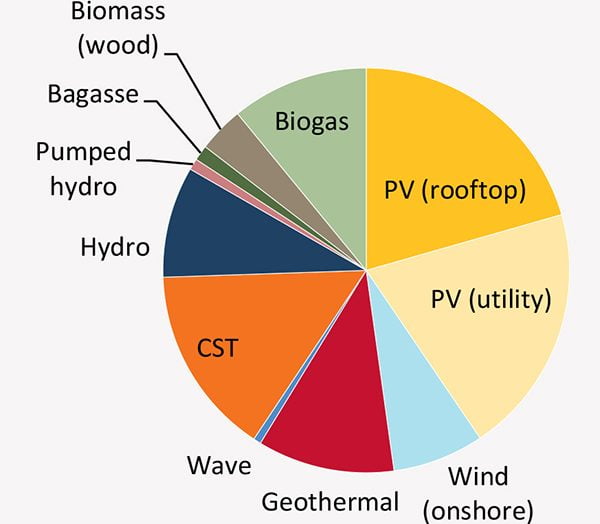
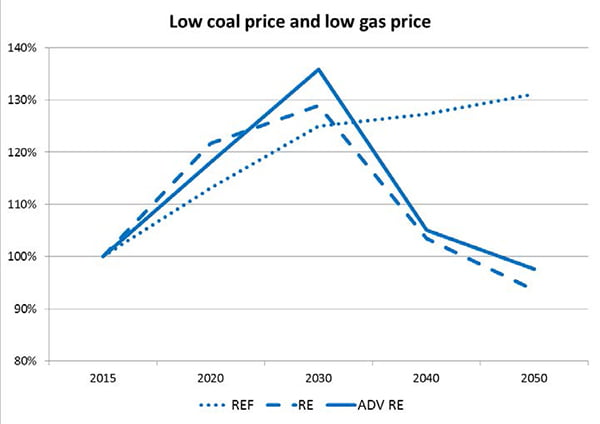
This article was first published in Issue 138 (January-March 2017) of Renew magazine.
 Renewable grid
Renewable grid
Is a floating solar boom about to begin?
Rob McCann investigates the world of floating solar energy systems.
Read more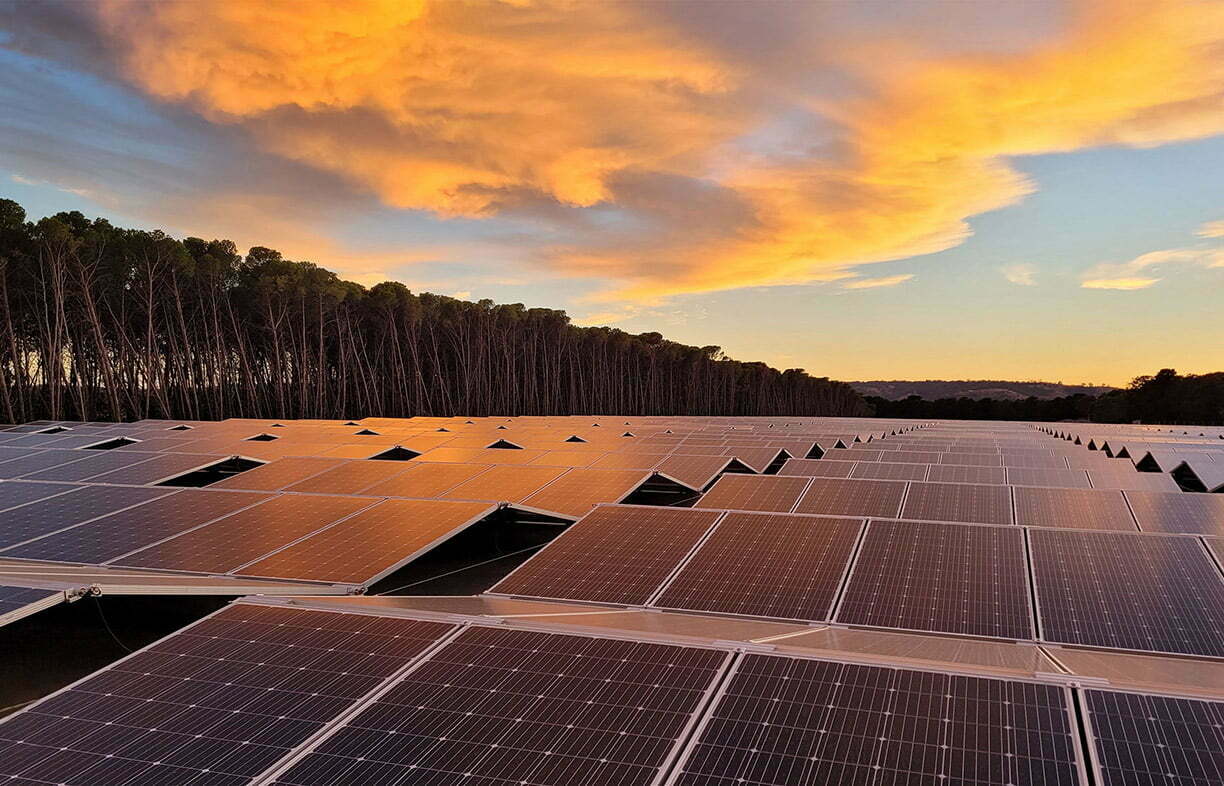 Electric vehicles
Electric vehicles
5B or not 5B
Large scale commercial solar farms can be time consuming to install and commission. Lance Turner looks at a company that has solved those issues.
Read more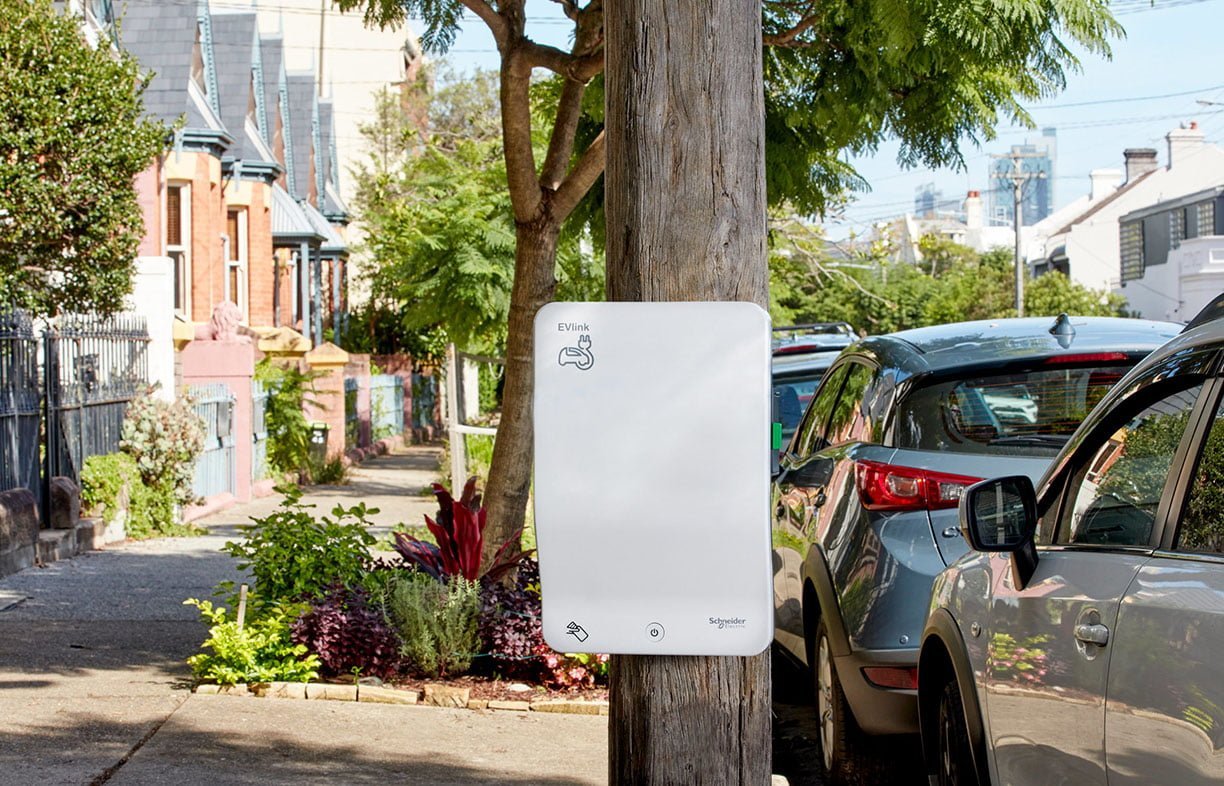 Electric vehicles
Electric vehicles
EV street charging trial
Rechargeable lithium batteries are critical for our modern world, but they do have a somewhat variable safety history. Lance Turner looks at the issues and what to do about them.
Read more
